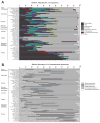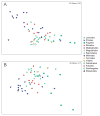The ecology of the phyllosphere: geographic and phylogenetic variability in the distribution of bacteria on tree leaves
- PMID: 20545741
- PMCID: PMC3156554
- DOI: 10.1111/j.1462-2920.2010.02258.x
The ecology of the phyllosphere: geographic and phylogenetic variability in the distribution of bacteria on tree leaves
Abstract
Large populations of bacteria live on leaf surfaces and these phyllosphere bacteria can have important effects on plant health. However, we currently have a limited understanding of bacterial diversity on tree leaves and the inter- and intra-specific variability in phyllosphere community structure. We used a barcoded pyrosequencing technique to characterize the bacterial communities from leaves of 56 tree species in Boulder, Colorado, USA, quantifying the intra- and inter-individual variability in the bacterial communities from 10 of these species. We also examined the geographic variability in phyllosphere communities on Pinus ponderosa from several locations across the globe. Individual tree species harboured high levels of bacterial diversity and there was considerable variability in community composition between trees. The bacterial communities were organized in patterns predictable from the relatedness of the trees as there was significant correspondence between tree phylogeny and bacterial community phylogeny. Inter-specific variability in bacterial community composition exceeded intra-specific variability, a pattern that held even across continents where we observed minimal geographic differentiation in the bacterial communities on P. ponderosa needles.
© 2010 Society for Applied Microbiology and Blackwell Publishing Ltd.
Figures




Similar articles
-
Bacterial succession on the leaf surface: a novel system for studying successional dynamics.Microb Ecol. 2009 Jul;58(1):189-98. doi: 10.1007/s00248-009-9495-y. Epub 2009 Feb 17. Microb Ecol. 2009. PMID: 19221834
-
Bacterial diversity in tree canopies of the Atlantic forest.Science. 2006 Jun 30;312(5782):1917. doi: 10.1126/science.1124696. Science. 2006. PMID: 16809531
-
Phyllosphere Metaproteomes of Trees from the Brazilian Atlantic Forest Show High Levels of Functional Redundancy.Microb Ecol. 2017 Jan;73(1):123-134. doi: 10.1007/s00248-016-0878-6. Epub 2016 Nov 16. Microb Ecol. 2017. PMID: 27853840
-
Distinctive phyllosphere bacterial communities in tropical trees.Microb Ecol. 2012 Apr;63(3):674-81. doi: 10.1007/s00248-011-9953-1. Epub 2011 Oct 12. Microb Ecol. 2012. PMID: 21990015
-
Role of phyllosphere fungi of forest trees in the development of decomposer fungal communities and decomposition processes of leaf litter.Can J Microbiol. 2006 Aug;52(8):701-16. doi: 10.1139/w06-023. Can J Microbiol. 2006. PMID: 16917528 Review.
Cited by
-
A review of pathogenic airborne fungi and bacteria: unveiling occurrence, sources, and profound human health implication.Front Microbiol. 2024 Sep 19;15:1428415. doi: 10.3389/fmicb.2024.1428415. eCollection 2024. Front Microbiol. 2024. PMID: 39364169 Free PMC article. Review.
-
A core phyllosphere microbiome exists across distant populations of a tree species indigenous to New Zealand.PLoS One. 2020 Aug 13;15(8):e0237079. doi: 10.1371/journal.pone.0237079. eCollection 2020. PLoS One. 2020. PMID: 32790769 Free PMC article.
-
Interactions of Methylotrophs with Plants and Other Heterotrophic Bacteria.Microorganisms. 2015 Apr 2;3(2):137-51. doi: 10.3390/microorganisms3020137. Microorganisms. 2015. PMID: 27682083 Free PMC article. Review.
-
Effects of Variety, Plant Location, and Season on the Phyllosphere Bacterial Community Structure of Alfalfa (Medicago sativa L.).Microorganisms. 2022 Oct 13;10(10):2023. doi: 10.3390/microorganisms10102023. Microorganisms. 2022. PMID: 36296299 Free PMC article.
-
Changes in the Microbial Community of Pinus arizonica Saplings After Being Colonized by the Bark Beetle Dendroctonus rhizophagus (Curculionidae: Scolytinae).Microb Ecol. 2019 Jul;78(1):102-112. doi: 10.1007/s00248-018-1274-1. Epub 2018 Oct 22. Microb Ecol. 2019. PMID: 30349964
References
-
- Andrews JH, Harris RF. The ecology and biogeography of microorganisms of plant surfaces. Annu Rev Phytopathol. 2000;38:145–180. - PubMed
-
- Cha S. Comprehensive survey on distance/similarity measures between probability density functions. Int J Math Models Meth Appl Sci. 2007;1:300–307.
-
- Chelius MK, Triplett EW. The diversity of archaea and bacteria in association with the roots of Zea mays L. Microb Ecol. 2001;41:252–263. - PubMed
Publication types
MeSH terms
Substances
Grants and funding
LinkOut - more resources
Full Text Sources
Molecular Biology Databases

